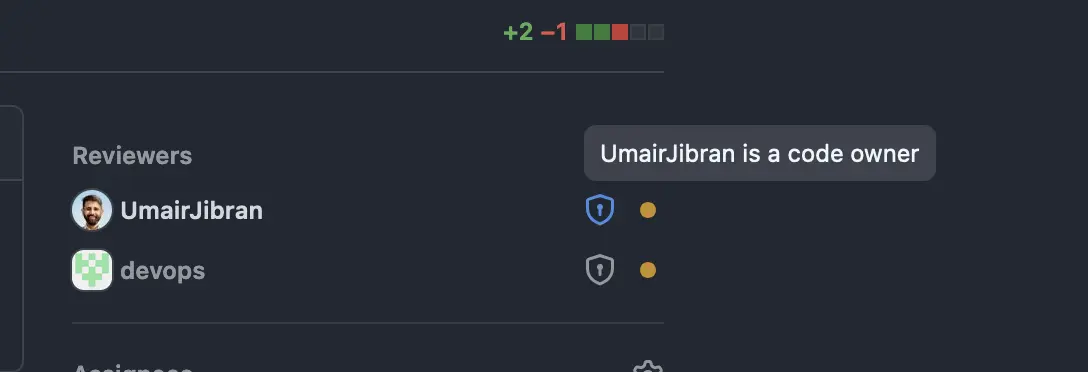GitHub CODEOWNERS: A Comprehensive Guide
Learn how to use GitHub's CODEOWNERS file to streamline your project's workflow. This guide covers everything you need to know about CODEOWNERS, including how to create and use it effectively.
Learn how to use GitHub's CODEOWNERS file to streamline your project's workflow. This guide covers everything you need to know about CODEOWNERS, including how to create and use it effectively.
CODEOWNERS: A Comprehensive GuideAs developers, maintaining and scaling a project involves handling multiple contributors, managing code reviews, and ensuring quality control. GitHub’s CODEOWNERS file is a powerful tool that simplifies this process by assigning ownership and responsibilities over specific parts of the codebase.
In this blog post, we’ll dive deep into how CODEOWNERS works, why it’s important, and how you can use it to streamline your project’s workflow.
CODEOWNERS file?CODEOWNERS?CODEOWNERS FileCODEOWNERSCODEOWNERS File?A CODEOWNERS file is a GitHub-specific file that allows repository maintainers to define who is responsible for which parts of the codebase. It can be used to assign ownership of files or directories to specific individuals or teams.
When changes are made to those areas of the code, the designated CODEOWNERS will automatically be requested for review. This ensures that the correct person or team is aware of changes and can give appropriate feedback.
CODEOWNERS FileThe CODEOWNERS file can be placed in a few locations, but the most common one is:
.github/CODEOWNERS
Alternatively, you can place it in the root directory or a docs/ folder:
/CODEOWNERS/docs/CODEOWNERSCODEOWNERS?When projects grow, it becomes increasingly difficult to ensure that changes are reviewed by the right people. The CODEOWNERS file helps by automating the process of assigning reviewers, ensuring that the right individuals or teams review code that affects their areas of expertise.

By clearly defining ownership, you promote accountability within your team. Owners are responsible for ensuring that changes made to their code are well-reviewed, documented, and maintain quality standards.

In large repositories, it’s common for different people to be responsible for different parts of the project (e.g., frontend, backend, documentation). A CODEOWNERS file helps distribute responsibilities and ensures that only relevant changes are sent to the correct owners for review.
CODEOWNERS FileCreating a CODEOWNERS file is simple. Let’s walk through the steps:
In your repository, create a new file called CODEOWNERS in the .github directory (or in the root or docs directory if you prefer).
.github/CODEOWNERS
In the file, specify the ownership rules by mapping file paths to GitHub usernames or teams.
Here’s an example of what a CODEOWNERS file might look like:
# Default owner for everything
* @default-owner
# Owner for the Python folder
/python/ @python-dev
# Owner for the frontend
/frontend/ @frontend-team
# Owner for Markdown files (documentation)
/*.md @docs-team
# Owner for JavaScript files anywhere in the repo
*.js @javascript-guru
Once you’ve defined the ownership rules, commit the file to your repository:
git add .github/CODEOWNERS
git commit -m "Add CODEOWNERS file"
git push origin main
Let’s break down the syntax of a CODEOWNERS file and the rules you can define.
You can specify ownership for entire directories or specific files. Ownership is defined using paths relative to the root of the repository.
# Assign ownership of the entire repo
* @owner
# Assign ownership of a specific directory
/path/to/directory/ @owner
# Assign ownership of a specific file
/path/to/file.js @owner
You can use wildcard patterns (*) to match multiple files.
*.js: All JavaScript files.docs/*.md: All Markdown files in the docs folder.# Assign ownership to all .md files in any directory
*.md @docs-owner
# Assign ownership to all JavaScript files
*.js @js-owner
You can assign multiple owners to a file or directory. Simply list them after the path, separated by spaces.
# Assign multiple owners
/frontend/ @frontend-team @js-owner
You can assign owners based on file extensions, which is useful for defining ownership of files like Markdown (.md) for documentation, or language-specific files like .js or .py.
# Assign ownership to all Python files
*.py @python-dev
CODEOWNERSIf your team is split into frontend, backend, and dev-ops, you can define ownership for specific parts of the codebase.
/frontend/ @frontend-team
/backend/ @backend-team
/infrastructure/ @devops-team
You can assign documentation ownership to ensure technical writers or documentation specialists review all changes to .md files.
*.md @docs-team
If certain team members specialize in specific languages, you can define ownership based on file extensions.
*.js @javascript-expert
*.py @python-guru
Not Defining a Default Owner
Forgetting to define a default owner (*) may leave certain files or directories unassigned, causing delays in the review process. Always set a fallback owner to cover any areas not explicitly defined.
Incorrect Wildcard Usage
Wildcard patterns can sometimes be misused. Make sure you understand how patterns work (* for any file, ** for recursive directories) to avoid assigning ownership incorrectly.
Over-Assigning Owners Assigning too many owners to a single file or directory can lead to review bottlenecks. Be selective about ownership to ensure the right people are reviewing changes.
The CODEOWNERS file is an essential tool for managing large projects with multiple contributors. It simplifies the code review process, promotes accountability, and ensures that changes are reviewed by the appropriate people. Whether you’re managing a small team or a large open-source project, CODEOWNERS helps keep your workflow efficient and your codebase healthy.
By setting up a well-structured CODEOWNERS file, you’ll ensure that your repository scales effectively while maintaining high code quality.